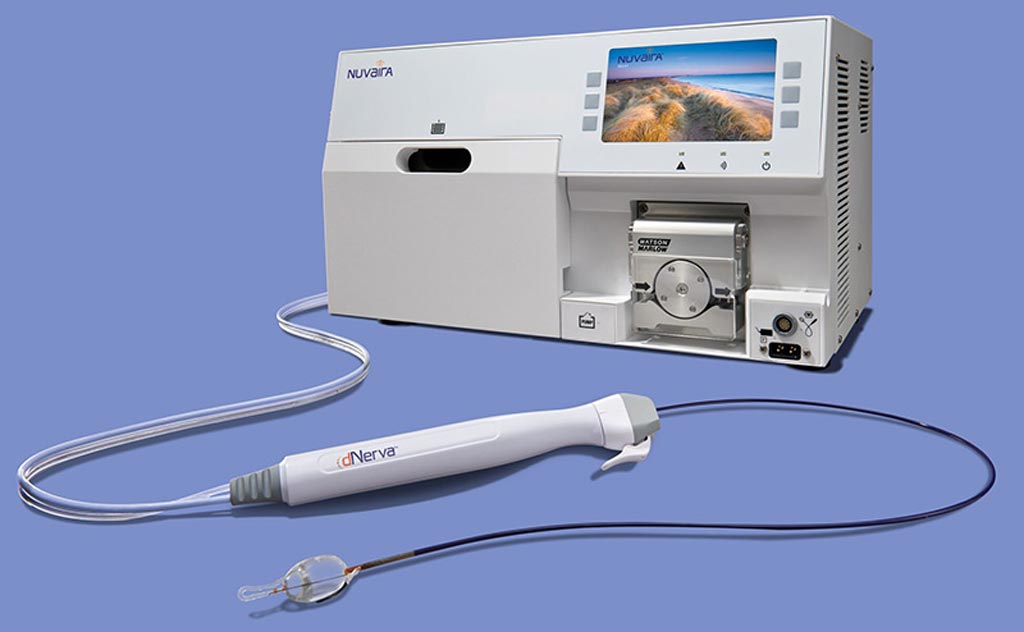Targeted Airway Ablation Reduces COPD Exacerbations
|
By HospiMedica International staff writers Posted on 11 Oct 2018 |

Image: The Nuvaira lung denervation system and dNerva dual cooled RFA catheter (Photo courtesy of Nuvaira).
Symptoms of persistent chronic obstructive pulmonary disease (COPD) can be significantly reduced when obstructed airways are opened by targeted lung denervation (TLD), claims a new study.
Researchers at University Medical Center Groningen (UMCG; The Netherlands), University Hospital Leuven (UZ Leuven, Belgium), and other institutions conducted a multinational phase 2 clinical study of the Nuvaira lung denervation system and dual cooled radiofrequency ablation (RFA) catheter probe. The trial included 82 patients (50% male, average age 64); half the participants underwent an outpatient TLD procedure, and the other half underwent a sham procedure.
During TLD, performed under general anesthesia, a bronchoscope is used to insert a balloon catheter that contains the RFA probe into the airway. Specific nerves are selectively ablated to target the cholinergic pathway, which regulates the inflammatory response and smooth muscle constriction. The esophagus itself is protected from the electrodes with a tissue-mimicking gel during the 75-minute procedure. In addition, all patients received tiotropium, an anticholinergic bronchodilator. Eighty-one patients completed a six-month follow-up.
The results revealed that TLD improved lung function in COPD patients; while 71% of the patients who received the sham treatment had an adverse respiratory event related to COPD, only 32% of the TLD patients suffered one. None of the patients died, and there were no TLD-related adverse effects. Five patients (12%) in the treatment group experienced gastrointestinal problems such as nausea, abdominal bloating, and digestion discomfort, which disappeared after six months. The study was presented at the European Respiratory Society International Congress, held during September 2018 in Paris (France).
“We have been able to significantly reduce chronic respiratory symptoms such as shortness of breath, exacerbations of the disease, infections and hospitalizations in a group of COPD patients who are already on aggressive medical therapy,” said lead author and study presenter Dirk-Jan Slebos, MD, PhD, of UMCG. “There was also a trend towards improved quality of life and better lung function in the treated patients. It's a new mechanism of treatment that will not replace drugs, but really strengthens them. From my point of view, it's really a step-up approach at the moment.”
The nervous system can suppress inflammation through the cholinergic anti-inflammatory pathway by stimulation of the vagus nerve, which controls parasympathetic tone, heart rate variability, and the release of acetylcholine, which in turn inhibits the inflammatory response by inhibiting release of pro-the inflammatory cytokines interleukin-6 and tumor necrosis factor (TNF). If pro-inflammatory cytokines are released over a prolonged period, they can exacerbate diseases such as rheumatoid arthritis (RA), inflammatory bowel disease, and atherosclerosis.
Related Links:
University Medical Center Groningen
University Hospital Leuven
Researchers at University Medical Center Groningen (UMCG; The Netherlands), University Hospital Leuven (UZ Leuven, Belgium), and other institutions conducted a multinational phase 2 clinical study of the Nuvaira lung denervation system and dual cooled radiofrequency ablation (RFA) catheter probe. The trial included 82 patients (50% male, average age 64); half the participants underwent an outpatient TLD procedure, and the other half underwent a sham procedure.
During TLD, performed under general anesthesia, a bronchoscope is used to insert a balloon catheter that contains the RFA probe into the airway. Specific nerves are selectively ablated to target the cholinergic pathway, which regulates the inflammatory response and smooth muscle constriction. The esophagus itself is protected from the electrodes with a tissue-mimicking gel during the 75-minute procedure. In addition, all patients received tiotropium, an anticholinergic bronchodilator. Eighty-one patients completed a six-month follow-up.
The results revealed that TLD improved lung function in COPD patients; while 71% of the patients who received the sham treatment had an adverse respiratory event related to COPD, only 32% of the TLD patients suffered one. None of the patients died, and there were no TLD-related adverse effects. Five patients (12%) in the treatment group experienced gastrointestinal problems such as nausea, abdominal bloating, and digestion discomfort, which disappeared after six months. The study was presented at the European Respiratory Society International Congress, held during September 2018 in Paris (France).
“We have been able to significantly reduce chronic respiratory symptoms such as shortness of breath, exacerbations of the disease, infections and hospitalizations in a group of COPD patients who are already on aggressive medical therapy,” said lead author and study presenter Dirk-Jan Slebos, MD, PhD, of UMCG. “There was also a trend towards improved quality of life and better lung function in the treated patients. It's a new mechanism of treatment that will not replace drugs, but really strengthens them. From my point of view, it's really a step-up approach at the moment.”
The nervous system can suppress inflammation through the cholinergic anti-inflammatory pathway by stimulation of the vagus nerve, which controls parasympathetic tone, heart rate variability, and the release of acetylcholine, which in turn inhibits the inflammatory response by inhibiting release of pro-the inflammatory cytokines interleukin-6 and tumor necrosis factor (TNF). If pro-inflammatory cytokines are released over a prolonged period, they can exacerbate diseases such as rheumatoid arthritis (RA), inflammatory bowel disease, and atherosclerosis.
Related Links:
University Medical Center Groningen
University Hospital Leuven
Latest Surgical Techniques News
- Minimally Invasive Endoscopic Surgery Improves Severe Stroke Outcomes
- Novel Glue Prevents Complications After Breast Cancer Surgery
- Breakthrough Brain Implant Enables Safer and More Precise Drug Delivery
- Bioadhesive Sponge Stops Uncontrolled Internal Bleeding During Surgery
- Revolutionary Nano Bone Material to Accelerate Surgery and Healing
- Superior Orthopedic Implants Combat Infections and Quicken Healing After Surgery
- Laser-Based Technique Eliminates Pancreatic Tumors While Protecting Healthy Tissue
- Surgical Treatment of Severe Carotid Artery Stenosis Benefits Blood-Brain Barrier
- Revolutionary Reusable Duodenoscope Introduces 68-Minute Sterilization
- World's First Transcatheter Smart Implant Monitors and Treats Congestion in Heart Failure
- Hybrid Endoscope Marks Breakthrough in Surgical Visualization
- Robot-Assisted Bronchoscope Diagnoses Tiniest and Hardest to Reach Lung Tumors
- Diamond-Titanium Device Paves Way for Smart Implants that Warn of Disease Progression
- 3D Printable Bio-Active Glass Could Serve as Bone Replacement Material
- Spider-Inspired Magnetic Soft Robots to Perform Minimally Invasive GI Tract Procedures
- Micro Imaging Device Paired with Endoscope Spots Cancers at Earlier Stage
Channels
Critical Care
view channel
Light-Based Technology to Measure Brain Blood Flow Could Diagnose Stroke and TBI
Monitoring blood flow in the brain is crucial for diagnosing and treating neurological conditions such as stroke, traumatic brain injury (TBI), and vascular dementia. However, current imaging methods like... Read more
AI Heart Attack Risk Assessment Tool Outperforms Existing Methods
For decades, doctors have relied on standardized scoring systems to assess patients with the most common type of heart attack—non-ST-elevation acute coronary syndrome (NSTE-ACS). The GRACE score, used... Read morePatient Care
view channel
Revolutionary Automatic IV-Line Flushing Device to Enhance Infusion Care
More than 80% of in-hospital patients receive intravenous (IV) therapy. Every dose of IV medicine delivered in a small volume (<250 mL) infusion bag should be followed by subsequent flushing to ensure... Read more
VR Training Tool Combats Contamination of Portable Medical Equipment
Healthcare-associated infections (HAIs) impact one in every 31 patients, cause nearly 100,000 deaths each year, and cost USD 28.4 billion in direct medical expenses. Notably, up to 75% of these infections... Read more
Portable Biosensor Platform to Reduce Hospital-Acquired Infections
Approximately 4 million patients in the European Union acquire healthcare-associated infections (HAIs) or nosocomial infections each year, with around 37,000 deaths directly resulting from these infections,... Read moreFirst-Of-Its-Kind Portable Germicidal Light Technology Disinfects High-Touch Clinical Surfaces in Seconds
Reducing healthcare-acquired infections (HAIs) remains a pressing issue within global healthcare systems. In the United States alone, 1.7 million patients contract HAIs annually, leading to approximately... Read moreHealth IT
view channel
Printable Molecule-Selective Nanoparticles Enable Mass Production of Wearable Biosensors
The future of medicine is likely to focus on the personalization of healthcare—understanding exactly what an individual requires and delivering the appropriate combination of nutrients, metabolites, and... Read moreBusiness
view channel
Philips and Masimo Partner to Advance Patient Monitoring Measurement Technologies
Royal Philips (Amsterdam, Netherlands) and Masimo (Irvine, California, USA) have renewed their multi-year strategic collaboration, combining Philips’ expertise in patient monitoring with Masimo’s noninvasive... Read more
B. Braun Acquires Digital Microsurgery Company True Digital Surgery
The high-end microsurgery market in neurosurgery, spine, and ENT is undergoing a significant transformation. Traditional analog microscopes are giving way to digital exoscopes, which provide improved visualization,... Read more
CMEF 2025 to Promote Holistic and High-Quality Development of Medical and Health Industry
The 92nd China International Medical Equipment Fair (CMEF 2025) Autumn Exhibition is scheduled to be held from September 26 to 29 at the China Import and Export Fair Complex (Canton Fair Complex) in Guangzhou.... Read more







.jpg)






